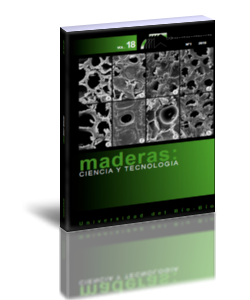Decay resistance of four fast-growing Eucalypts wood exposed to three types of fields
Keywords:
Biodegradation, biodeterioration, Corymbia, density, Eucalyptus, lightness.Abstract
The evaluation of wood durability enables the definition of reliable parameters to predict the servicelife of wood-based products. This study aimed to evaluate the wood deterioration of four fast-growing eucalypts species (Eucalyptus botryoides, Corymbia citriodora, Eucalyptus paniculata e Eucalyptustereticornis) exposed to three field tests (outdoor, flooded site and forest canopy) during 540 days. The physical properties measured were: mass loss, density and moisture content. Furthermore, we determined changes in wood color by CIEL*a*b* method and performed a visual analysis by CEN
grades. Among the four wood eucalypts, Eucalyptus tereticornis presented the highest decay resistance. The flooded site presented the best conditions for the proliferation of xylophagous agents. Mature wood was least susceptible to deterioration than juvenile wood.
Downloads
Download data is not yet available.
Downloads
How to Cite
de Avila Delucis, R., Gonzales de Cademartori, P. H., Missio, A. L., & Gatto, D. A. (2016). Decay resistance of four fast-growing Eucalypts wood exposed to three types of fields. Maderas. Ciencia Y Tecnología, 18(1), 33–42. Retrieved from https://revistas.ubiobio.cl/index.php/MCT/article/view/2236
Issue
Section
Article

































